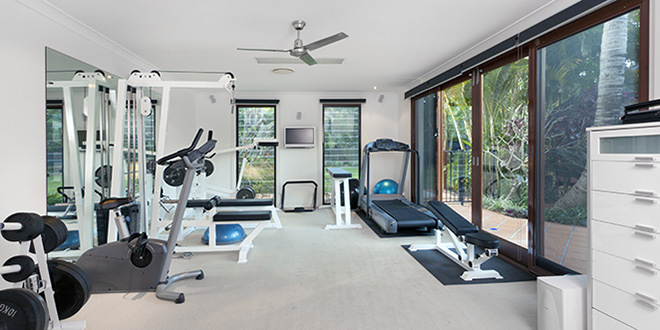A lot of time, thought, effort, and money can go into building a home gym that offers everything you’re looking for. Exercise variety, safety, aesthetics and also budget are all concerns when it comes to outfitting the home gym of your dreams.
While many of us are keen to focus on the positive aspects of having a gym in our home, the negatives are often ignored until after the equipment is ordered.
Let’s take a quick look at the good and bad of working out at home, before delving further into what you need to consider:
Advantages of Owning a Home Gym
- Time savings: Obviously, you don’t need to track to the gym day in and day out. Nor will you have to wait in line to use the equipment you want to use. Or sit around in the change room waiting when the showers are full.
- Workout the way you want: With a home gym, you decide what equipment goes in your gym and what doesn’t. This is really beneficial when you don’t have many choices for what local gym to workout in, and the selection doesn’t satisfy your needs.
- Cost savings: Few new home gym owners are able to see this benefit. Namely, because buying home gym equipment costs money, usually as much as a year or two of gym fees (depending on what your commercial gym charges). However, a home gym quickly pays itself off and the savings start to become apparent soon after buying the equipment.
Drawbacks of Owning a Home Gym
- Space: Space is a big problem if you live in an apartment, condo, small house and/or you have a large family with little room to spare. While all-in-one home gym machines like Bowflex and others offer a multitude of exercises with a small footprint, you still may not be able to cram every piece of equipment you want into your home.
- Need self-motivation: One could make the argument that it takes motivation just to get your butt into the gym every day with all the driving, waiting, etc., that’s often required. However, first time home gym owners often experience a certain sense of loss when they suddenly realize there are no pretty girls or handsome fellas to spur them on to new heights in their workouts.
- Safety: Even if you have no gym buddies to go with, there’s always someone who’s willing to give you a spot when you’re at the gym – even a gym employee if the place is empty. Not so, if you are home by yourself. This mostly applies to free-weight equipment, which is why BestHomeGym.net advocates buying equipment that’s self-spotting and not dangerous to use.
Now that you’ve got a few pros and cons to consider, let’s move to building this thing. That is, if you’re still up for it!
Workout Choices: How do You Like/Want to Workout?
Hopefully, this is obvious to you already. If you’ve never worked out before at all, it might be best to grab a guest pass for a local gym (or two) so you can try out a bunch of different equipment to see what suits you best.
There are tons of equipment choices to mull over, and you have to consider safety and workout space before you decide on equipment.
Common Equipment to Consider:
- All-in-ones: Perfect for working the entire body while only making a one-time purchase of a single piece of equipment. If you’re looking to build lots of strength and muscle, read the maximum resistance the machine can accommodate (including upgrades to the weight stack) before committing. Check out our top choices here.
- Barbells, benches, dumbbells: These are all common pieces of the home gym equipment to consider, but only if you have the space to set them all up and use them. Keep in mind that safety becomes a concern here when considering benching, squatting, cleaning, etc., without a spotter. Consider space-saving options like plate trees, storage racks and adjustable dumbbells if you go this route.
- Kettlebells: Kettlebells take up less space than all the above and offer a great workout. However, if you want to get into serious muscle building, they’re somewhat limited when it comes to compound movements they can offer.
- Treadmill, elliptical trainer or an exercise bike would certainly be an awesome addition to your home gym. But none of this is cheap and will require additional space.
- Accessories: Most accessories can be easily stowed away. Things like yoga mats, weight belts, wrist straps, joint wraps, machine attachments, mirrors, workout shoes, and much more. Don’t get too crazy with these types of purchases at first because: A) You don’t know how much you’ll use them, B) The costs can really add up!
Once you’ve decided on the type of movements you want to perform, then it’s time to see if you have enough room for it.
Space Requirements: Do You Have Enough?
One of the reasons we recommend all-in-one style home gyms so much on this blog is because they’re so practical for a home user with limited space. Even if you have plenty of space to spare, such as an entire garage or basement, how much equipment do you really want to cram in there?
Things like benches, barbells, dumbbells, kettlebells, mats, etc., all seem pretty small until you have one of everything and find yourself tripping all over the place while you workout. Really take the time to measure your space and compare it to the in-use footprint of all the equipment you want to outfit the gym with.
And if you want a particular all-in-one gym, you’ll need to compare the footprint listed in the product description with the space you have available. Length and width are something to consider, but most users mess up on matching the height of the gym they want with the intended space. Ideally, you want at least a foot of clearance between the highest point of the machine and your ceiling.
Flooring: Is What You Have Currently Going to Work?
Flooring considerations, though not regarded as important to some people, comes down to the equipment you’ll buy. First and foremost, you need to determine whether the floor can handle the weight of the equipment.
Basement and garage flooring shouldn’t be a concern if they’re poured cement or concrete. Upper floors of a house should really be assessed by a professional to determine whether safety is a concern, unless you know for sure it can bear the load. That is, unless you’re only buying a lightweight Bowflex or a couple of kettlebells in which case a simple floor mat or two is all that will usually be required.
Free weight equipment can do a real number on carpeting, certainly on a finished surface you want to protect. This means buying protective thick rubber mats to place under all the equipment, as well as to do floor exercises like deadlifts.
The same holds true if you’re buying an all-in-one, though generally you can buy one or two rubber protective mats to accommodate the equipment’s footprint.
Closing Thoughts
That covers all the important stuff you should be considering before you start building your home gym. The best advice is to start out small and build your home gym slowly.
After all, one of the top 3 benefits of owning your own home gym is the costs savings!
Figure out what’s most important to you to get started, then add more equipment and features as you become more comfortable working out in your own space.
 Best Home Gym Reviews and Tips for Your Home Gym
Best Home Gym Reviews and Tips for Your Home Gym






